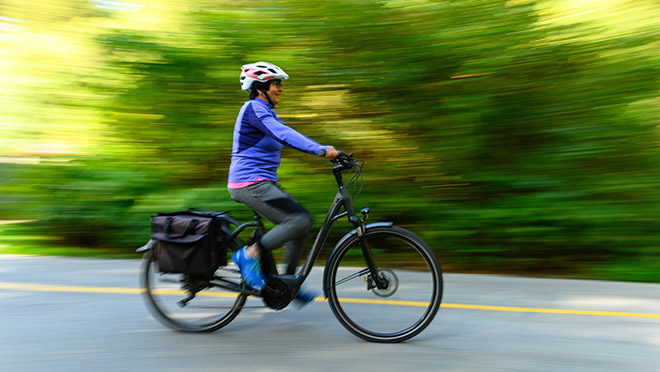Buzz off! E-bike etiquette helps us all get along

E-bikes are all the rage, but sharing streets and bike lanes is a challenge
Some people hate cars. Some distrust cyclists. Others rage against pedestrians. And more recently, people have been irked by the behaviour of some who ride electric bikes.
E-bikes can be a great eco friendly option for the city commute, and their rise in popularity is both exciting and mildly alarming. Like pedestrians who walk and text in crosswalks, motorists who think they own the road, and cyclists who don't adhere to the rules of the road, the arrival of heedless e-bike riders has further complicated safety in what is a complex ballet on our streets.
Dave is an East Vancouver dad and bike commuter who, at least until the COVID-19 pandemic hit, regularly towed his son to daycare in a trailer behind a (non-electric) bike. He's a big fan of e-bikes, but has experienced several near-collisions as riders silently passed by him at warp speed.
"I use (Vancouver's) Adanac bike route, and there are a couple of kind of hilly sections that are a bit narrow, like when you're getting on the Dunsmuir Viaduct at Main Street," says Dave. "You have people do kind of 'Evel Knievel-style' passes with inches to spare, and almost clipping the child trailer on the back. It's a combination of jealousy and resentment for me, because I think they're cool machines, but based on my experience, there's a lack of courtesy for those moving slower than they are."
Dave's experience isn't uncommon. Few e-bike riders, or fast cyclists for that matter, use their bell or their voice to alert others that they're coming up fast from behind. Even a clear "Coming up on your left" can help avoid a potential collision. And in tighter sections, it gives the slower rider a chance to move to the right to provide a safe lane for a pass.
But there's a lot of trial and error going on. Trevor is an early adopting e-biker who has been riding for a couple years and is hesitant to use the bell on his bike out of fear of intimidating or surprising a slower rider.
"I always feel like I don't want to ding-ding-ding them, as they may get flustered and move right in front of you," says Trevor. "Quite often I talk to them, and it's a good idea to slow down too."
That's where a nice "Coming up on your left" comes in handy without feeling pushy.
Trevor notes that on roadways without bike lanes, he found that car drivers often miscalculated the speed of the e-bikes and would sometimes cut him off, assuming for instance, that they had lots of time to make a right turn when they didn't. But that has since changed.
"I think the speed of e-bikes surprised a lot of drivers at first, but they seem to be getting used to the idea now," says Trevor. "Many of them now know to wait until they make that right turn."
Go By Bike Week in Canada runs May 31 to June 6, 2021. See the links below for information and events in your area.
E-bike etiquette: 4 things to minimize risk
1. Know local rules and guidelines
Talk to someone at your local bike shop or check online for specifics for your town or city. In B.C., the basic rules are that you don't need a license to ride an e-bike that combines bicycle pedal power with electric motor assistance and has a top speed of 32 km/h on level ground. You need to be at least 16 years of age, wear a helmet, and abide by the same road rules as cars and bikes.
2. Be seen
It's safer for all involved when cyclists of all kinds, including e-bike riders, wear brighter clothing and employ front and back lights as soon as it starts to get dark.
3. Be heard
Bikes of all kinds are usually quiet. So while it may seem off-putting to ding-ding everyone you pass, it's a good idea to use a bell or your voice to let people know you're coming up from behind, especially in tight spots.
4. Stay off the Vancouver seawall
Vancouver prohibits electrically-assisted bikes, skateboards, hoverboards, scooters and Segways from Vancouver's popular seawall.
It's up to drivers, pedestrians, cyclists and skaters to co-exist
Everyone has a role to play – including pedestrians and motorists – in keeping things safe and peaceful on our streets, walkways, and trails.
Don't be the pedestrian who hogs a shared-use path, wanders into a bike lane, or gets lost in a smartphone conversation as the 'don't walk' signal flashes and a motorist risks getting stranded in the intersection waiting for you to cross.
And while it can be tough to make a right turn in a car through a bike lane, always shoulder check to ensure no cyclists are positioned in your blind spot you initiate your turn. And after you park on a street, take a moment to check in your side mirror to see if there's a cyclist approaching before you open the door.
Cut off as a cyclist? Giving the driver the benefit of the doubt and offering a calm reminder beats a smack on a car hood or a loud tirade. We're all learning to get along here.
Oh, and if you're a cyclist tempted to chat on the phone... don't. The same no-mobile phones bylaws that apply to drivers also apply to cyclists.